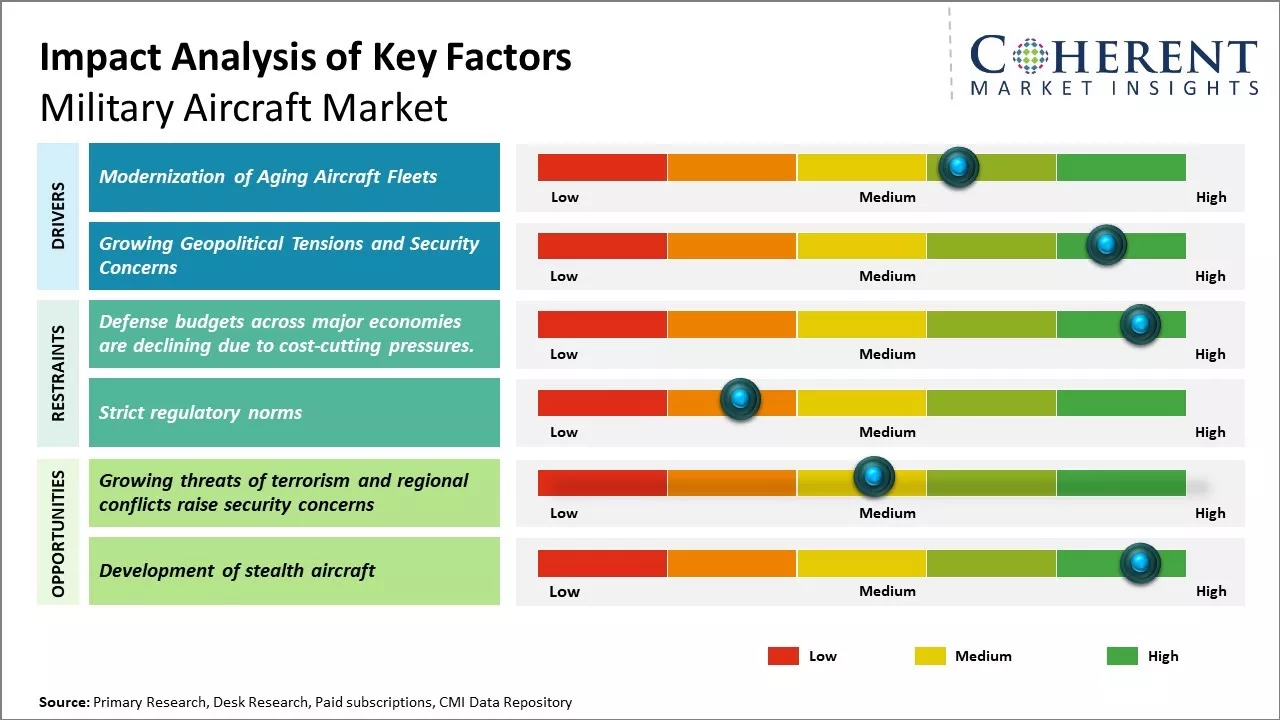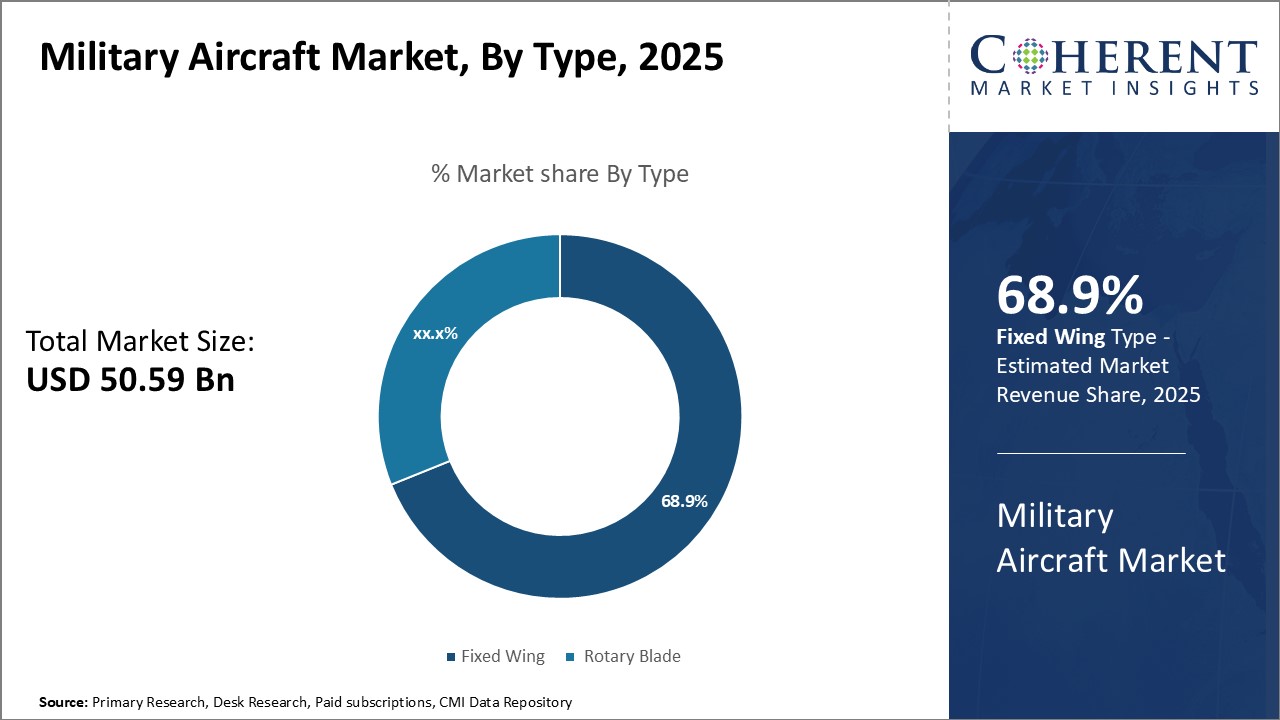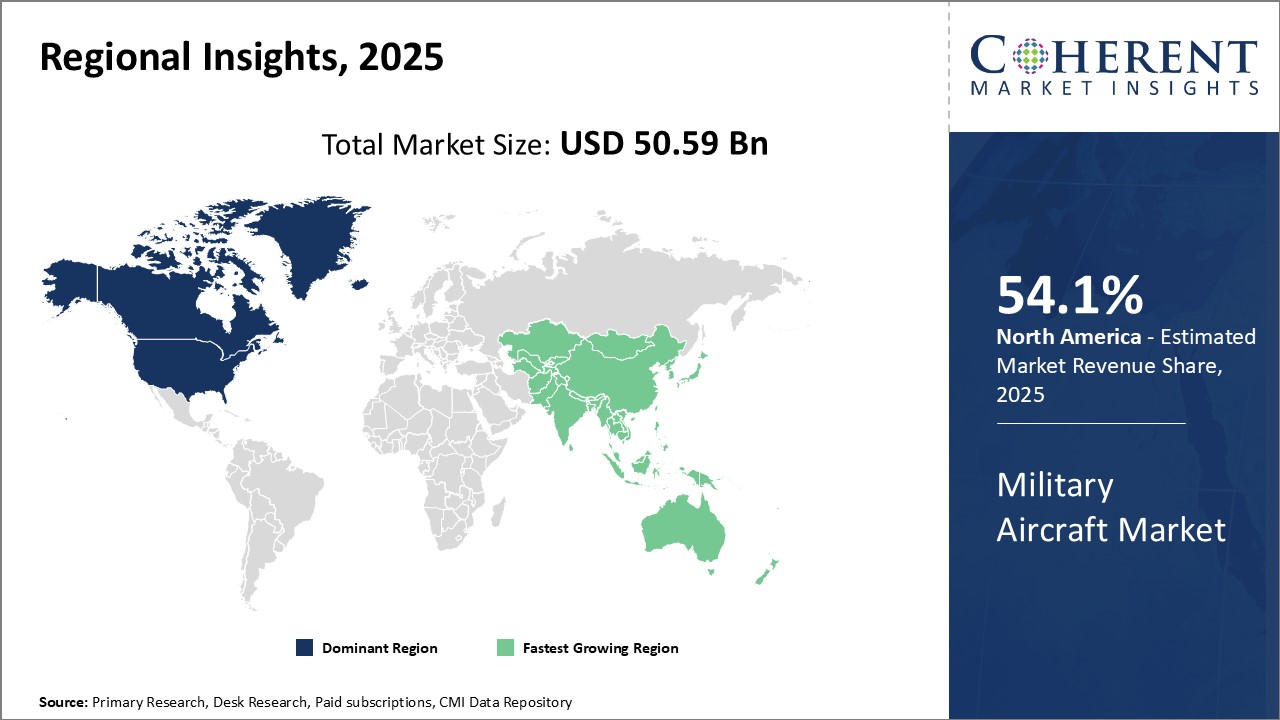Global military aircraft market is estimated to be valued at US$ 50.59 Bn in 2025 and is expected to reach US$ 70.29 Bn by 2032, exhibiting a compound annual growth rate (CAGR) of 4.8% from 2025 to 2032.

Discover market dynamics shaping the industry: Request sample copy
Global military aircraft market is expected to witness positive growth over the forecast period due to rising geopolitical tensions across regions supplementing the demand for military aircraft fleet modernization. Furthermore, increasing defense budget allocation of emerging economies such as China, India, South Korea is expected to create new opportunities for aircraft OEMs. However, high investment costs associated with the development and procurement of new aircraft may hamper the market growth. Key players operating in the market are focusing on reducing production costs by investing in additive manufacturing and advanced composite materials to gain a competitive edge in the market.
Modernization of Aging Aircraft Fleets
As military aircraft fleets around the world are aging, countries are investing heavily in modernizing their existing aircraft as well as procuring new advanced aircraft. The average age of aircraft fleets for countries like the U.S., Russia, China, and some Western European nations is over 25-30 years. While these countries have been able to extend the life of existing aircraft through several avionics, structural, and systems upgrades, newer threats and technology advancements are making the older aircraft less capable and viable. Upgrading or replacing these aging fleets become a top priority for military modernization plans. Countries want their air forces equipped with the latest sensors, weapons, self-protection systems as well as increased networking capabilities to gain an edge over adversaries. This is a big reason why militaries are spending a lot of money from their defense budgets to either improve current aircraft or buy new, more advanced multi-purpose aircraft.

Get actionable strategies to beat competition: Request sample copy
Growing Geopolitical Tensions and Security ConcernsGrowing geopolitical tensions between nations as well as heightened security concerns have led to increased defense spending and a focus on strengthening military capabilities. While diplomatic relations among some countries may have improved, the overall security environment remains uncertain. Militaries are on high alert due to fights over land, countries wanting nuclear weapons, the risk of terrorism across borders, and unstable situations in different parts of the world. This has especially impacted the global demand for military aircraft as countries look to project air power and safeguard national interests. Nations want to convey strength by expanding their aerial strike capabilities through advanced jet fighters, bombers, surveillance aircraft as well as build stronger air defense systems through interceptors and airborne early warning platforms. Non-state actors acquiring sophisticated weapons have also heightened the need for countries to modernize their aircraft fleets with superior networking and intelligence capabilities and acquire specialized aircraft like aerial refuelers to support out-of-area operations. Geopolitical tensions boosts demand for military aircraft as nations prepare for future security challenges

To learn more about this report, Request sample copy
Market Challenge: Defense budgets across major economies are declining due to cost-cutting pressures.Defense budgets across major economies are declining due to cost-cutting pressures. This reduction in spending impacts procurement of new platforms.
High investment and maintenance costs associated with military jets pose significant financial burdens. Geopolitical tensions among world powers introduce unpredictability in defense planning. Changing nature of warfare also increases uncertainty regarding future requirements.
Market Opportunity: Growing threats of terrorism and regional conflicts raise security concerns
Growing threats of terrorism and regional conflicts raise security concerns, incentivizing upgrade of ageing fleets. There has been rising demand for capabilities like network-centric warfare, C4ISR systems and unmanned aircraft. New technologies offer potential for lower maintenance and production costs. Additionally, countries are cooperating more on co-development and exports to optimize resources.

Discover high revenue pocket segments and roadmap to it: Request sample copy
Insights, By Type- Advancements in engine and airframe technology drives the fixed wing segment growthBy Type, fixed wing segment is estimated to contribute the highest share owing 68.9% in 2025 of the military aircraft market due to continuous advancements in engine and airframe technology. Fixed wing aircraft are preferred for their high payload capacity and long flight endurance. The fixed wing segment growth is driven by development of new engine configurations that improve fuel efficiency and thrust-to-weight ratio. Leading OEMs are focusing on open rotor and geared turbofan engine programs to reduce operating costs for fixed wing platforms. Advancements in composite materials and additive manufacturing have allowed design of lighter airframes. This enables fixed wing aircraft to carry more advanced avionics, weapons and sensor payloads without loss of performance.
Countries around the world are modernizing their aircraft fleets with new fixed wing platforms featuring advanced Fly-by-wire flight control systems, glass cockpits and integrated avionics. For instance, the U.S. procured F-35 and F/A-18 fighter jets to replace aging fleets. Whereas, India has introduced the Tejas Light Combat Aircraft and is developing the Fifth Generation Advanced Medium Combat Aircraft program. Such fleet modernization initiatives are favoring growth of the fixed wing segment. Furthermore, unmanned combat aerial vehicles which have fixed wing design are witnessing increased export orders for intelligence, surveillance and reconnaissance missions.
Insights, By Application- Evolving threat landscape boosts demand for combat aircraft
BY application, combat segment is estimated to contribute the highest share owing 38.7% in 2025 of the global military aircraft market due to the evolving threat landscape across regions, and this prompt Armed Forces to bolster their combat capabilities. As newer threats emerge from advanced air defense networks and new generation fighter jets, there is a pressing need to update legacy combat aircraft fleets. Furthermore, evolving tactics of terrorists groups relying on unmanned systems have necessitated deployment of next-gen combat platforms with networked warfare capabilities.
Leading countries are pouring investments into 6th generation fighter programs with advanced stealth, sensor fusion, cyber security and autonomous mission systems. For instance, the U.S. developed NGAD aircraft through DARPA's Pentagonal program. Whereas, France, Germany and Spain had partnered for the Future Combat Air System. Such new programs aim to counter advanced air defenses as well as provide air forces networked perimeter defense through unmanned wingmen. Upgrades of existing fleets through avionics, weapons and structural upgrades are also driving combat aircraft procurement. Rising defense budgets and strong demand from countries in Middle East and Asia Pacific will continue aiding growth of the combat segment in the coming years.
Insights, By Payload- Requirement for intelligence collection drives below 50 ton payload segment growth
By payload, below 50 tons segment is estimated to contribute maximum share owing 47.2% in 2025 of the global military aircraft market due to growing need for intelligence collection and aerial reconnaissance missions among Armed Forces worldwide. Lightweight aircraft below 50 tons are preferred for such roles as these offer longer flight endurance and ability to deploy from short runways near frontlines. These pose minimal radar signature that is ideally suited for intelligence gathering near enemy airspace without being detected.
Notable programs driving below 50 ton segment include the multi-mission MQ-9 Reaper drones ordered by USAF for ISR and precision strike. European nations have contracted Heron and Global Hawk UAVs from Israel and Northrop Grumman respectively. Demand is also surging for manned aircraft with signals intelligence and electronic support measures packs. For instance, Japan procured P-1 maritime patrol aircraft equipped with powerful radar to maintain situational awareness. Several countries are inducting aircraft modified with satellite communication capabilities to share real-time battlefield imagery with tactical units. This segment will continue receiving orders as focus rises on networking intelligence assets with frontline troops to enable faster decision making across armed forces.

Need a Different Region or Segment? Customize now
North America has dominated the global military aircraft market for decades owing 54.1% in 2025. With the large defense budgets of countries like the U.S., the region is home to many of the world's largest defense contractors who specialize in military aviation such as Lockheed Martin, Boeing, and Northrop Grumman. These companies have years of experience developing and producing fighters, bombers, transport aircraft as well as unmanned systems for the U.S. military and its allies. Given the massive size of the U.S. defense budget alone, North American OEMs receive significant contracts from the Pentagon which has allowed them to continually invest in R&D and manufacturing capabilities. The region is also a net exporter of military aircraft with countries around the world procuring planes like the F-15, F-16, F-18 from American manufacturers.
Asia Pacific is expected to experience rapid growth in the military aircraft sector. With rising geopolitical tensions and modernization of armed forces, many countries in the region like China, India, and Japan have substantial procurement plans over the next decade. China in particular has demonstrated ambition to reduce its dependence on foreign military equipment by indigenously developing platforms. Several Chinese state-owned aerospace companies have made big investments in 5th generation combat aircraft programs. The high costs of imported planes have led other Asian nations to consider joint development and production programs to lower costs. As defense budgets rise across Asia Pacific, more contracts will be available for aircraft, helicopters, and associated services, which is drawing the attention of global OEMs. The region's burgeoning aviation and industrial sectors also provide opportunities for co-production and partnerships to gain a foothold in this fast-growing market.
Military Aircraft Market Report Coverage
| Report Coverage | Details | ||
|---|---|---|---|
| Base Year: | 2024 | Market Size in 2025: | USD 50.59 Bn |
| Historical Data for: | 2020 To 2024 | Forecast Period: | 2025 To 2032 |
| Forecast Period 2025 to 2032 CAGR: | 4.8% | 2032 Value Projection: | USD 70.29 Bn |
| Geographies covered: |
|
||
| Segments covered: |
|
||
| Companies covered: |
Airbus SAS, Dassault Aviation, Lockheed Martin Corporation, Textron Inc., Boeing, Leonardo S.p.A, Northrop Grumman, Pilatus Aircraft Ltd, Russian Helicopters, Saab AB, Hindustan Aeronautics Limited, General Electric, FACC AG |
||
| Growth Drivers: |
|
||
| Restraints & Challenges: |
|
||
Uncover macros and micros vetted on 75+ parameters: Get instant access to report
*Definition: Military aircraft market involves the design, development, production and sale of military aircraft to Armed Forces around the world. It includes fighter jets, transport aircraft, helicopters, training aircraft as well as sophisticated targeting and surveillance systems. Key players in this market manufacture military aircraft tailored for specific missions like air superiority, ground attack, electronic warfare, aerial refueling, airborne early warning and control, and search and rescue operations. Countries spend billions annually to acquire advanced military aircraft technology for national security purposes.
Share
Share
About Author
Suraj Bhanudas Jagtap is a seasoned Senior Management Consultant with over 7 years of experience. He has served Fortune 500 companies and startups, helping clients with cross broader expansion and market entry access strategies. He has played significant role in offering strategic viewpoints and actionable insights for various client’s projects including demand analysis, and competitive analysis, identifying right channel partner among others.
Missing comfort of reading report in your local language? Find your preferred language :
Transform your Strategy with Exclusive Trending Reports :
Frequently Asked Questions
Joining thousands of companies around the world committed to making the Excellent Business Solutions.
View All Our Clients
US Reciprocal Tax Impact Analysis On Military Aircraft Market
Stay updated on tariff changes with expert insights and timely information